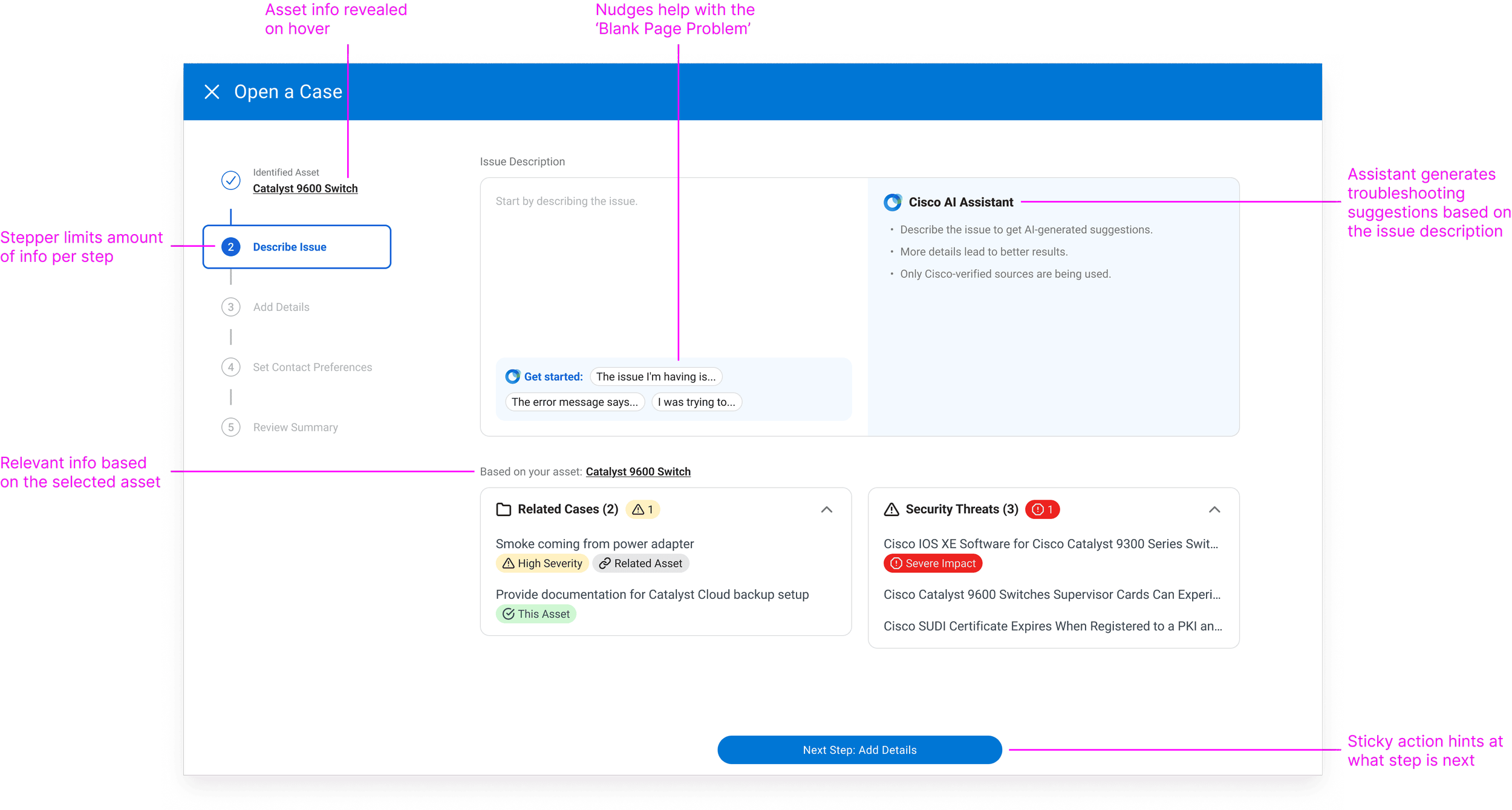
AI-Driven Self-Help
Saving Cisco $15M annually by enabling self-help on a $1 billion revenue customer experience platform.
Summary
I led a team of 9 in creating a new AI-driven self-help system on Cisco's customer experience SaaS platform.
By showing business analyst estimates of UX-driven outcomes, I influenced stakeholders to pivot the product strategy.
The solution saves Cisco $15M per year by deflecting 3% of the overall support case volume (1.7M in 2024).
Reduction in support operations cost
↓ $ 15M / year
Reduction in support case volume
↓ 3%
Overview
Company
Cisco
Timeline
Nov 2023 – 24
Team (16)
4 Product Designers
2 Visual Designers
3 Content Designers
2 UX Researchers
3 Product Managers
3 Software Engineering Leaders
My role
Lead Designer
Interaction Designer
Visual Designer
Prototyping
Design System
Project Manager
Pivoting A Migration Project
Stakeholders demanded migrating legacy features into the new experience.
I influenced a pivot by providing evidence that a redesign would benefit both sides:
Customers gain access to new AI-powered self-help.
Cisco saves money by customers self-solving instead of engaging in 1:1 support.
Opportunity“Improving self-help could save Cisco up to $25M / year.”
– Business Analyst, Cisco Customer Support
3 Areas Of Focus
Once I had buy-in for the redesign, I structured the project into three areas to focus the team’s efforts:
Smarter Intake
Streamline support case opening.
Remove clutter.
Helpful Context
Suggest helpful context.
Make sources accessible.
Self-Help Hook
Helpful AI-generated suggestions.
Nudge to provide more information.
Designing A Smarter Intake
The concept centers around generating troubleshooting suggestions from the open-ended issue description.
Trained on Cisco’s 40 years of resolving 1.7M (as of 2024) support cases annually, a proprietary LLM generates troubleshooting suggestions from the issue description of a support case.
Removing clutter simplified the workflow:
moving asset information into the stepper and
auto-generating several form fields so users don’t have to.
Designing For Trust
Interviewees feared hallucinations, meaning AI can generate false information.
Users became more trusting when I designed these:
Clear relationships between suggestions and sources
Accessible sources to verify truth and credibility.
Cutting Clutter
I discovered 3 troubleshooting phases, each using different information:
Gather context based on the selected asset,
Describe the issue and troubleshoot, and
Continue to open a case.
As users go through the phases, only relevant information is shown while previous info collapses.
Before
After
Making Context Helpful
28% of Cisco’s support cases could be resolved quickly just by providing information.
Contextual suggestions provide relevant information upfront, like related cases and security threats.
A filter rule prevents opening a support case if an asset is already in the replacement process (RMA).
Self-Help Hook
A checklist turned out to be the ideal format to present self-help suggestions.
Checking off suggestions lets users generate better suggestions based on what they had tried before.
Users were increasingly motivated to use the feature
The checklist gets passed to support to speed up resolution.
$15M Annual Cost Reduction
Instead of opening a ticket for every little issue, customers can now self-solve effectively.
Business analysts estimate that Cisco’s overall support case volume will decrease by 3%, resulting in $15M per year in savings in support operations costs.
Reduction in support case volume
↓ 3%
Reduction in support operations costs
↓ $ 15M / year
Exploring The Future
Customers used to buy Cisco because of their best-in-class customer support.
What about moving forward?
I explored strategic evolutions of leveling-up support case management.
Exploration #1Self-Help Copilot
An AI assistant helps users self-solve issues through an open-ended conversation in natural language.
Copilot can:
Ask questions to clarify,
Based on the input, find assets and threats in the network environment, and
Fix the problem for the user.
Exploration #2Support cases area
Customer support on Cisco’s CX Cloud was basic: a list of open support cases with a button to open a new one.
I explored growing case management into a holistic support area covering more of the customer support journey.
Explore More Projects
Dynamic Asset Groups
Turned asset group management dynamic from uploading static CSV files. Solved 3 years of customer complaints.
Infrastructure Platform
Modernized 30-year-old on-premise solutions into a SaaS platform. Secured 24 large customer renewals.












